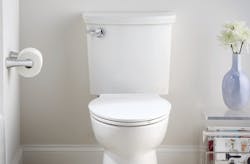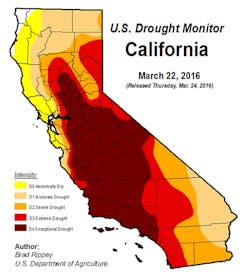If you’ve been in the plumbing industry long enough, you remember when those first-generation low-flow toilets came on the market. Likely you received many calls from angry customers and did your best to find solutions.
When the federal government enacted The Energy Policy Act of 1992, it mandated minimum efficiency standards for toilets, urinals, showers and faucets manufactured in the United States after 1994. For toilets, that meant going from 3.5 gal. per flush to 1.6 gpf. Plumbing manufacturers said the short implementation period was not enough time to engineer these “low-flow” toilets for optimal performance.
Their complaints fell on deaf ears, so they did the best they could in the amount of time they had. Inevitably, the first generation of 1.6 gpf toilets was not well-received by the public as many people had to flush two or three times for their toilets to flush properly. How is that saving water?
Faucets and showers went from as high as 8 gallons per minute to 2.5 gpm. Consumers complained that the lower water volume in the shower wasn’t enough to completely wash off soap or shampoo. So people took longer showers. Again, it seemed people were using more water to deal with the low performance of the new fixtures.
Over the next few years, plumbing manufacturers stepped up efforts to re-engineer faucets and fixtures to address the performance issues their customers were objecting to. In 2006, the U.S. Environmental Protection Agency created the WaterSense program (http://www.epa.gov/watersense), a voluntary national program that certifies plumbing products using 20 percent less water than the federal minimum standard — without the performance issues of the earlier generations. Today, it also serves as an outlet for water conservation education.
It’s the memory of those first-generation of low-flows that hinders the use of such products by some consumers today, notes Paul Stefano, general manager of plumbing franchise Benjamin Franklin Plumbing of Charlotte, N.C. (http://www.benfranklinclt.com).
“When the government mandated that we were going to 1.6-gpf toilets, there was a lot of trouble with the way they were designed in the beginning,” he explains. “Either they’d get stopped up easily or you’d have to flush them two or three times. People always had a plunger left next to the toilet. I do believe it left a bad taste in a lot of people's mouths. Now, the technology has gotten fantastic.”
But some of his customers are still reluctant to make the switch, he adds, so unless the china is cracking or the toilet is beyond repair, they keep having the old toilets rebuilt. “Some of the toilets are 30, 40 years old,” Stefano says. “They may not look the best but people just love the way they flush.”
He believes that people who want to conserve water do it for “personal reasons” — they may want to save money on their water and sewage bills or they’ve educated themselves on the environmental reasons.
Rob Zimmerman, director of WASH (water, sanitation and hygiene) and sustainability for Kohler Co. (http://www.us.kohler.com), agrees: “There are definite pockets of consumers who are more concerned about water conservation than others, and we find that the reasoning is different based sometimes on region, sometimes on personal preference, such as cost savings and the desire to conserve natural resources.”
In the not-concerned column are homeowners in the resort area of Harbor Springs, Mich. “We live on Lake Michigan, plus most of our customers have private wells,” explains Julie Wieman, president of MacGregor Plumbing (http://www.macgregorplumbing.com) in Harbor Springs. “Our town is on top of about 1,000 artesian wells; we have some of the best drinking water in the world. So no, we don’t get requests from customers about water-saving fixtures.”
It’s an entirely different situation for residents in California, which has been in a severe drought for about the last five years. In 2015, Gov. Jerry Brown enacted a mandatory 25 percent reduction in water use for all towns and cities.
“Homeowners’ awareness of water conservation varies based on the region of the country,” says Lovin Saini, senior product manager for Gerber Plumbing (http://www.gerberonline.com). “In states such as California, Vermont and others who have led the way in regulating water, homeowners are very aware for the need to conserve. Many of their purchase decisions revolve around the need to comply with the rules in place.”
In April, the California government noted that because of the increased snowpack in the mountains and rain across the state, the drought was officially over. However, it warned a drought situation most likely would come back to California soon.
“Because of that, San Diego County now has permanent water conservation in place,” explains MaryJean Anderson, president of Anderson Plumbing, Heating and Air (http://www.andersonplumbingheatingandair.com), located in El Cajon, Calif., just outside San Diego. “California has had drought conditions longer than any other state, so our company has installed a lot of water-saving products over the years.”
Gray Uhl, director of brand education for American Standard (http://www.americanstandard-us.com), DXV and Grohe (http://www.grohe.us), notes: “Even in areas unaffected by regulations, a growing number of homeowners are looking for high-performance, water-conserving faucets and fixtures to reduce water use and cost without sacrificing performance. Design trends research also indicates that interior designers are seeing high-efficiency plumbing products becoming more mainstream in new homes and remodeling projects.”
More than WaterSense
For consumers still worried about the performance of today’s water-saving products, the WaterSense label may give them the evidence they need to feel comfortable with the lower flow rates.
“Homeowners who are aware of the EPA program are realizing that WaterSense certification means more than just meeting requirements on lower water usage,” Saini says. “It means having to meet or exceed performance standards when the product operates at that lower water flow. That’s important to homeowners, especially for products such as toilets, faucets and showerheads. They don’t want to sacrifice the flushing functionality of a toilet or the great shower experience they get in order to save water.”
Zimmerman notes that consumers who shop for energy-efficient appliances and lights usually look for water-efficient products, too. “But largely we see consumers expecting plumbing products to save water without having to search for specific models,” he says.
“It is a useful tool that allows the consumer to make an educated choice,” Uhl says. “It is to plumbing products what Energy Star is to home appliances.”
For Stefano’s customers, it comes down to managing expectations and reconciling the old with the new.
“People like to be comfortable, so if they're not getting the right pressure out of it, they are going to call a plumber back and say the WaterSense product doesn’t work as well as the old showerhead,” he explains. “People just aren't used to it. If they basically want to power wash themselves in the shower and now they can't, they don't like it. They're wanting a plumber to get it back to the way it was.”
Stefano focuses on other ways his clients can save water — hot water recirculation systems. For a small investment, these systems can get hot water to the furthest fixture in a matter of seconds.
“Our educational process for recirculating system involved taking a 1 gal. milk jug and putting it under a particular fixture and then running it until the water starts to get hot, measuring it as we go along,” he says. “We'll run it and then pour it out, run it and pour it out. Think about doing that several times a day all year long; you're going to waste a lot of water and run up your utility bills.”
The long-running drought in California means that homeowners already have the water-conserving fixtures and faucets they need. On service calls, Anderson Plumbing advocates looking at the whole plumbing system, and the first thing on the checklist is water pressure. “If you have more than 80-PSI coming into your home, we want to adjust it downward to save money,” Anderson says. “I came from a nursing background, and I know that blood pressure and water pressure are similar.”
Her techs use the analogy with clients: When you go to a doctor, the very first thing they check is your blood pressure. High blood pressure can indicate several things, such as problems with vision, kidneys and heart.
“You can have so many different things and typically it all stems from your blood pressure,” she explains. “And water pressure is no different. In a high-pressure situation, you probably have a water leak, which not only wastes water but increases utility bills. So we always recommend a pressure-reducing valve, as well as recirculation systems.”
In the early years of California’s drought, Anderson Plumbing used to conduct water surveys when on service calls. The company installs grey water or recycled waters systems and also provided, for a limited time, rain barrels on certain installations to collect the condensate from HVAC equipment.
“Offering these options builds trust with consumers,” Anderson says. “We felt like we were helping the community as well as helping boost business for us.”
Promoting conservation
Educating customers on the benefits of water-conserving products continues to be necessary, especially as plumbing technology evolves. “Now that toilet designs have come out to actually flush better, people are not as upset as they have been, and they're more apt to buy a new product that will conserve more water than trying to keep the old 3.5-gpf models,” Stefano notes.
American Standard and its parent company LIXIL believe that investing in and developing new technology is essential for getting homeowner buy-in on sustainability products. “These innovations appeal to homeowners interested in the reduced costs that these products offer, but who may be skeptical about the functionality of water-conserving plumbing products,” Uhl says.
During those first few years of the California drought, Anderson Plumbing did its bit for promoting water-conserving plumbing products from doing public service announcements to providing free water conservation kits. They discontinued both as the San Diego area became completely retrofitted with water-saving toilet, faucets and showerheads. Area utilities still use the kits, Anderson says; they consisted of six 1.5 gal. per minute aerators, two 1.75 gpm Moen showerheads, one Eco Showermate water-pressure-boosting shower pump, and one Body Glove portable water filter sports bottle.
An in-house water audit checklist included such items as a check of the water pressure regulator, a dye test for toilets to look for water leaks and a pressure-drop test to look for leaks throughout the entire system, Anderson recalls.
Kohler has many ways it promotes water conservation to consumers, including its #CommitToSix (http://www.commit.kohler.com) campaign. For every person who pledges to take a six-minute shower, Kohler donates $1 to the Nature Conservancy, up to $10,000. It also has a dedicated website, www.kohler.com/watersaving, with links to all its WaterSense-labeled products, as well as tips for saving water and information on Kohler’s outside partnerships.
Zimmerman notes: “Kohler includes water savings messaging on product packaging in-aisle at retail locations, on the website, in showroom literature, through our BOLD Experience Trailers that are traveling across the country to help trades and consumers better understand our plumbing products’ benefits and installation, and advertising and ecommerce promotions.”
Gerber provides articles and tips shared with homeowners on websites, blogs and social media that help educate people on how to “save water and why it benefits them and the world overall,” Saini says.
“We feel it’s a responsibility we have in the market as a manufacturer and as homeowners to conserve water in the most effective ways possible,” he explains. “It’s a real environmental concern that is not going to go away and we all need to do our part. We make a point to communicate the important fact that performance does not need to be sacrificed in order to conserve water.”
Kelly Faloon is a contributing writer and editor to Contractor magazine.
About the Author

Kelly L. Faloon
Freelance Writer/Editor
Kelly L. Faloon is a contributing editor and writer to CONTRACTOR, Contracting Business magazine and HPAC Engineering and principal of Faloon Editorial Services. The former editor of Plumbing & Mechanical magazine, Faloon has more than 26 years of experience in the plumbing and heating industry and more than 35 years in B2B publishing. She started a freelance writing and editing business in 2017, where she has a varied clientele.
Faloon spent 3 1/2 years at Supply House Times before joining the Plumbing & Mechanical staff in 2001. Previously, she spent nearly 10 years at CCH/Wolters Kluwer, a publishing firm specializing in business and tax law, where she wore many hats — proofreader, writer/editor for a daily tax publication, and Internal Revenue Code editor.
A native of Michigan’s northern Lower Peninsula, Faloon is a journalism graduate of Michigan State University. You can reach her at [email protected].


